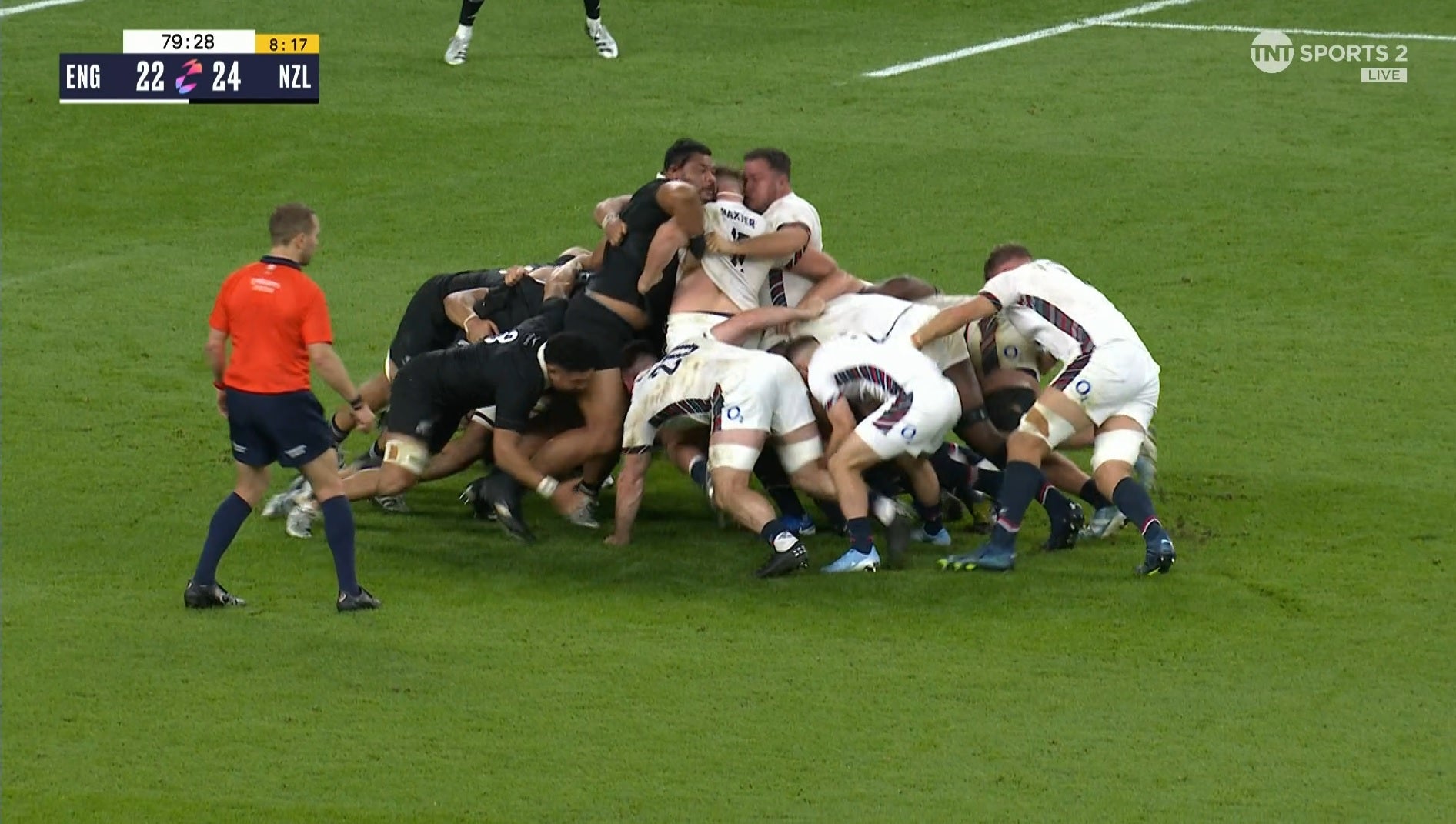For England, it has become a familiar feeling. For the third time this year, Steve Borthwick’s side let a game slip from their grasp, squandering a golden opportunity to secure a rare win over the All Blacks as George Ford missed twice with his boot in the final minutes.
After Mark Tele’a’s brilliant finish and Damian McKenzie’s superb touchline conversion nudged New Zealand ahead, Ford was handed a first chance to snatch victory from the tee as Anton Lienert-Brown was penalised for a high tackle.
When his penalty clanged back off the upright, that appeared to be that. Yet a Patrick Tuipulotu knock-on in contact gave England one last opportunity.
It set up just about the perfect scenario from which to launch a match-winning play: a midfield scrum about 10 metres from the opposition line.
So what went wrong in the passage leading up to Ford’s miss? Here, The Independent analyses England’s errors in those final moments.
1. The scrum
A worrying trend in England’s recent final-quarter collapses has been their failure to sustain a scrum effort across 80 minutes. It was apparent in their semi-final defeat to South Africa at last year’s World Cup, and their problems have not been solved since, even with varying personnel against an array of opposition.
The starting pack had fronted up well to a strong All Blacks scrummaging unit, with Ellis Genge and Will Stuart performing strongly at prop. But after the pair were replaced by rookie Fin Baxter and veteran Dan Cole, England began to creak, conceding a couple of penalties at the set piece. Mention must be given here to New Zealand’s replacements Pasilio Tosi and the outstanding Tuipulotu, who combined to add plenty of mass (260kg) and menace.
For the final scrum, England had Jamie George back on the field after a head injury to Theo Dan, while starting lock pair George Martin and Maro Itoje were packing down in the second row. The trio are England’s best scrummaging unit, but Tosi attacked the space between George and Baxter, sending the home captain up into the air and forcing the rest of the eight to retreat. It put pressure on scrum half Harry Randall at the base.


2. Passing errors
The wobbly scrum forced a hurried extraction from Randall, who panicked a little under pressure. England had lined up with their two distributors (Ford and George Furbank) directly behind Ben Earl at No 8, keeping New Zealand guessing by being ready to rush either way if England got a nudge on. As the ball came to the base, Ford and Furbank scurried to the attacking left, ready for Randall’s pass. Just before the scrum is set, Ford wanders forward to check that Randall is sure of the call.
The problem is that with his forwards under pressure, Randall felt unable to make the transfer, with Ardie Savea (stationed on the openside rather than at No 8) off the scrum quickly. The zippy nine tries to salvage the situation by darting right, only to find support lacking, and in the end throwing a rushed pass back the other way in Ford’s vague direction. The fly half manages to gather and avert total disaster, but a thumping tackle from Tuipulotu means England have lost 10 metres already.

From here, Randall reloads impressively, composing himself and picking out his forward carriers to enable Ford to recover and drop into the pocket. But with ruck ball slow, England wait and wait to set up a drop goal for victory. When the moment eventually arrives, a messy ruck means sluggish possession and a floaty, slightly inaccurate pass from Randall.
3. The drop goal
Ford manages to get a handle on Randall’s transfer, but it takes time to bring the ball down into position to put boot to ball. England’s zig-zagging, meanwhile, has left plenty of exhausted forwards off their feet or out of action, leaving little traffic for potential New Zealand blockers to sift through on their way to trying to charge down Ford’s attempt. Those twin factors leave the kicker under greater pressure than he’d like, with Cam Roigard virtually upon Ford as he strikes.

England drill the skill as often as possible in training, with their array of fly halves working regularly with Jonny Wilkinson and assistant coach Kevin Sinfield. Ford has shown before to be a master of the art, striking thrice in the win over Argentina in Marseille at the start of the World Cup.
But this was the veteran playmaker’s first action for a month after suffering a quad injury playing for Sale against Saracens – did rust or lingering impact of that injury play a factor? It is impossible to say for sure, but his effort wobbles and fades in the air, leaving England beaten.
“There are a lot of experienced players on the pitch there and they know what we were trying to do,” head coach Borthwick said afterwards. “We get in a position to almost convert and we didn’t miss by too much.
“If you look over the last period of time, the team in those drop goal situations has been pretty successful. We weren’t today but ultimately this is the width of the post. That’s the reality. It is the width of the post that the result goes one way or the other and that’s the nature of Test rugby when you have two good teams.”

